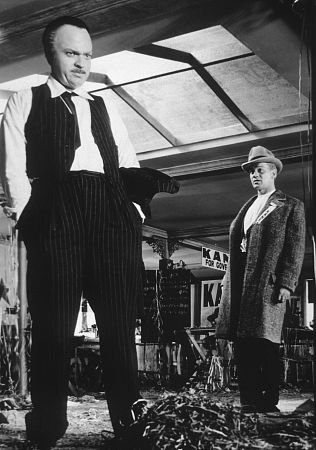 In the movie “Citizen Kane,” Orson Welles uses many cinematographic aspects in order to create a Hollywood masterpiece. When we see Kane (Orson Welles) in the movie he is usually looked at with either a close-up or a low-angle. We tend to see him in a close-up when the director wants us to pay attention to his facial expressions. For example, when Susan Alexander (Dorothy Comingore) has just finished with her opera singing, Kane stands up and claps as hard as he can. We then see a close up of his face and are shown how concentrated he is on trying to in a way sway the audience into believing that he really thinks she’s good. The scene after this shows the viewer Susan’s view of Kane as he yells at her. The camera produces a low angle shot which shows us the fear that Kane instills in her. This camera angle really shows how powerful and daunting Kane is. There is one point in the film where we see Kane as weak and this is produced again by a low angle shot. After Kane loses the election we see that Kane is alone in a room which was supposed to hold a celebration (as shown in the picture above). Seeing Kane through a low angle really shows us how alone and how he truly feels.
In the movie “Citizen Kane,” Orson Welles uses many cinematographic aspects in order to create a Hollywood masterpiece. When we see Kane (Orson Welles) in the movie he is usually looked at with either a close-up or a low-angle. We tend to see him in a close-up when the director wants us to pay attention to his facial expressions. For example, when Susan Alexander (Dorothy Comingore) has just finished with her opera singing, Kane stands up and claps as hard as he can. We then see a close up of his face and are shown how concentrated he is on trying to in a way sway the audience into believing that he really thinks she’s good. The scene after this shows the viewer Susan’s view of Kane as he yells at her. The camera produces a low angle shot which shows us the fear that Kane instills in her. This camera angle really shows how powerful and daunting Kane is. There is one point in the film where we see Kane as weak and this is produced again by a low angle shot. After Kane loses the election we see that Kane is alone in a room which was supposed to hold a celebration (as shown in the picture above). Seeing Kane through a low angle really shows us how alone and how he truly feels.
Wednesday, October 3, 2007
Citizen Kane
 In the movie “Citizen Kane,” Orson Welles uses many cinematographic aspects in order to create a Hollywood masterpiece. When we see Kane (Orson Welles) in the movie he is usually looked at with either a close-up or a low-angle. We tend to see him in a close-up when the director wants us to pay attention to his facial expressions. For example, when Susan Alexander (Dorothy Comingore) has just finished with her opera singing, Kane stands up and claps as hard as he can. We then see a close up of his face and are shown how concentrated he is on trying to in a way sway the audience into believing that he really thinks she’s good. The scene after this shows the viewer Susan’s view of Kane as he yells at her. The camera produces a low angle shot which shows us the fear that Kane instills in her. This camera angle really shows how powerful and daunting Kane is. There is one point in the film where we see Kane as weak and this is produced again by a low angle shot. After Kane loses the election we see that Kane is alone in a room which was supposed to hold a celebration (as shown in the picture above). Seeing Kane through a low angle really shows us how alone and how he truly feels.
In the movie “Citizen Kane,” Orson Welles uses many cinematographic aspects in order to create a Hollywood masterpiece. When we see Kane (Orson Welles) in the movie he is usually looked at with either a close-up or a low-angle. We tend to see him in a close-up when the director wants us to pay attention to his facial expressions. For example, when Susan Alexander (Dorothy Comingore) has just finished with her opera singing, Kane stands up and claps as hard as he can. We then see a close up of his face and are shown how concentrated he is on trying to in a way sway the audience into believing that he really thinks she’s good. The scene after this shows the viewer Susan’s view of Kane as he yells at her. The camera produces a low angle shot which shows us the fear that Kane instills in her. This camera angle really shows how powerful and daunting Kane is. There is one point in the film where we see Kane as weak and this is produced again by a low angle shot. After Kane loses the election we see that Kane is alone in a room which was supposed to hold a celebration (as shown in the picture above). Seeing Kane through a low angle really shows us how alone and how he truly feels.
Subscribe to:
Post Comments (Atom)

2 comments:
Very insightful on how the camera angles were used. The angles that were used really did show exact intentions on what they wanted the audience to see and watching the movie I could see that each cam angle suited the scene perfectly.
Very nice, I believe that the angles were to show what the audience wantes to see, and by watching Kane, it made him good and bad at the same time.
Post a Comment